Digital Posters
Diffusion Applications: Brain & Spine
ISMRM & SMRT Annual Meeting • 15-20 May 2021

| Concurrent 3 | 15:00 - 16:00 |
 |
2043.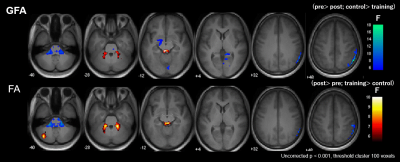 |
Cognitive training-derived microstructural and functional neuroplasticity and the neural mechanisms underlying the far-transfer effect
Daisuke Sawamura1,2, Ryusuke Suzuki3, Shinya Sakai1, Keita Ogawa4, Xinnan Li2, Hiroyuki Hamaguchi2, and Khin Khin Tha5
1Department of Rehabilitation Science, Hokkaido University, Sapporo, Japan, 2Department of Biomarker Imaging Science, Hokkaido University, Sapporo, Japan, 3Department of Medical Physics, Hokkaido University Hospital, Sapporo, Japan, 4Department of Rehabilitation, Hokkaido University Hospital, Sapporo, Japan, 5Global Center for Biomedical Science and Engineering, Hokkaido University Faculty of Medicine, Sapporo, Japan
Little is known about how microstructural and functional neuroplasticity occurs upon cognitive training and the relationship between cognitive training-derived brain changes and cognitive performance. This prospective study aimed to elucidate cognitive training-derived neuroplasticity and the mechanism underlying transfer effects using diffusion spectrum imaging (DSI) and resting-state functional MRI (rsfMRI). The results suggest that the right inferior parietal lobule and its neural connections and the right cerebellar vermis may modulate the far-transfer effect.
|
||
2044.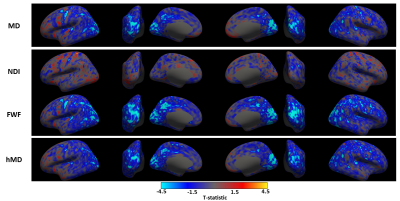 |
Quantifying tissue microstructural changes associated with short-term learning using model-based diffusion MRI
Michele Guerreri1, Thomas Villemonteix2,3, Whitney Stee3, Evelyne Balteau4, Philippe Peigneux3,4, and Hui Zhang1
1Computer Science & Centre for Medical Image Computing, University College London, London, United Kingdom, 2Laboratoire de Psychopathologie et Neuropsychologie, Saint Denis, Paris 8 Vincennes - St Denis University, Paris, France, 3Neuropsychology and Functional Neuroimaging Research Group (UR2NF) at the Centre for Research in Cognition and Neurosciences (CRCN), Université Libre de Bruxelles, Brussels, Belgium, 4Cyclotron Research Centre, University of Liège, Liège, Belgium
We use model-based diffusion MRI to assess microstructural changes associated with short-term plasticity. Neuroplasticity changes are the foundation of experience. These mechanisms include microstructural rearrangements which can manifest even after short learning episodes. DTI has proven effective in highlighting such changes. However, the connection with the underlying microstructural processes remains speculative. Biophysical modelling can help interpreting such changes. We use NODDI and CHARMED models to examine MD changes obtained in a spatial navigation task. NODDI’s FWF and CHARMED’s hMD share similar cortical patterns of decrease as MD. FWF exhibited higher sensitivity than MD and hMD to capture microstructural changes.
|
|||
2045.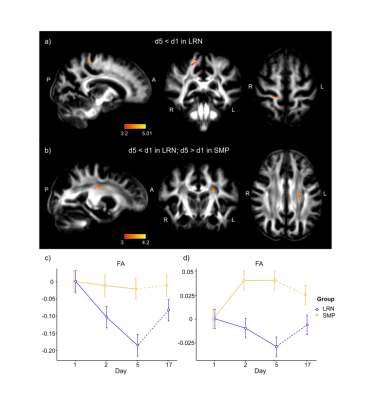 |
White matter microstructure associated with functional connectivity changes following short-term learning of a visuomotor sequence
Stefanie A. Tremblay1,2, Anna-Thekla Jäger3, Julia Huck1, Chiara Giacosa1, Stephanie Beram1, Uta Schneider3, Sophia Grahl3, Arno Villringer3,4,5,6, Christine Lucas Tardif7,8, Pierre-Louis Bazin3,9, Christopher J Steele3,10, and Claudine J. Gauthier1,2
1Physics, Concordia University, Montreal, QC, Canada, 2Montreal Heart Institute, Montreal, QC, Canada, 3Neurology, Max Planck Institute for Human Cognitive and Brain Sciences, Leipzig, Germany, 4Clinic for Cognitive Neurology, Leipzig, Germany, 5Leipzig University Medical Centre, IFB Adiposity Diseases, Leipzig, Germany, 6Collaborative Research Centre 1052-A5, University of Leipzig, Leipzig, Germany, 7Biomedical Engineering, McGill University, Montreal, QC, Canada, 8Montreal Neurological Institute, Montreal, QC, Canada, 9Faculty of Social and Behavioral Sciences, University of Amsterdam, Amsterdam, Netherlands, 10Psychology, Concordia University, Montreal, QC, Canada
To characterize the temporal dynamics of plasticity, we conducted a longitudinal MRI study at ultra-high field (7T) during the learning process of a sequential visuomotor task, in a learning and control group. WM microstructure was altered in the tracts underlying the primary motor and sensorimotor cortices, and in tracts adjacent to the right supplementary motor area (SMA), where changes in functional connectivity were also found in this cohort. Our study provides evidence for short-term white matter plasticity in the sensorimotor network, where the SMA would play a key role in linking the spatial and motor aspects of motor sequence learning.
|
|||
2046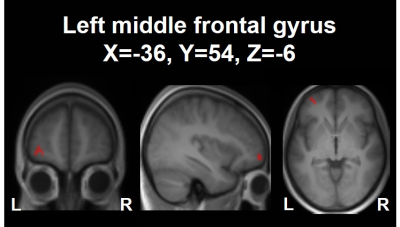 |
Tissue Microstructural Changes following Four-Week Neurocognitive Training: Observations of Double Diffusion Encoding MRI Video Permission Withheld
Xinnan Li1, Daisuke Sawamura2, Hiroyuki Hamaguchi1, Yuta Urushibata3, Thorsten Feiweier4, Keita Ogawa5, and Khin Khin Tha1,6
1Department of Biomarker Imaging Science, Graduate School of Biomedical Science and Engineering, Hokkaido University, Sapporo, Japan, 2Department of Functioning and Disability, Faculty of Health Sciences, Hokkaido University, Sapporo, Japan, 3Siemens Healthcare K.K., Tokyo, Japan, 4Siemens Healthcare GmbH, Erlangen, Germany, 5Department of Rehabilitation, Hokkaido University Hospital, Sapporo, Japan, 6Global Center for Biomedical Science and Engineering, Faculty of Medicine, Hokkaido University, Sapporo, Japan
A four-week neurocognitive training of spatial attention and working memory was conducted in 21 volunteers. A change in tissue microstructure was tested by using double diffusion encoding MRI, which revealed a decrease in μFA in the left middle frontal gyrus. This decrease showed a significant negative correlation with the changes in the response time as assessed by the orienting attention network test.
|
|||
2047.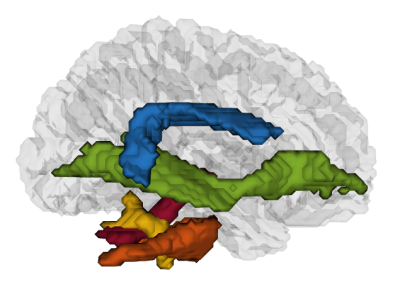 |
Microstructural alterations in the white matter of children with dyslexia assessed by multi-fascicle diffusion compartment imaging
Nicolas Delinte1, Claire Gosse2,3, Laurence Dricot3, Quentin Dessain1, Mathieu Simon1, Benoit Macq1, Marie Van Reybroeck2,3, and Gaetan Rensonnet1
1ICTEAM, UCLouvain, Louvain-la-Neuve, Belgium, 2IPSY, UCLouvain, Louvain-la-Neuve, Belgium, 3IoNS, UCLouvain, Brussels, Belgium
Dyslexia is a deviant development of both reading and spelling abilities affecting 5-12 % of children, yet the microstructural changes it induces in the white matter (WM) remain incompletely understood. This study analyzed multi-shell diffusion MRI on a population of 17 dyslexic children and 18 controls. Advanced models (Diamond & Microstructure Fingerprinting), able to separately characterize intersecting fascicles within a voxel, obtained stronger correlations with children's reading and spelling performances than traditional DTI and showed increased sensitivity. The novel indices, obtained from these models, suggested refined interpretations of the microstructural characteristics of dyslexia in WM pathways.
|
|||
2048.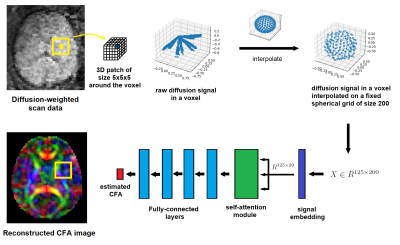 |
Robust estimation of the fetal brain architecture from in-utero diffusion-weighted imaging
Davood Karimi1, Onur Afacan1, Clemente Velasco-Annis1, Camilo Jaimes1, Caitlin Rollins1, Simon Warfield1, and Ali Gholipour1
1Boston Children's Hospital, Harvard Medical School, Boston, MA, United States
Diffusion weighted magnetic resonance imaging (DW-MRI) of fetal brain is challenged by fetal and maternal motion, low signal-to-noise ratio and short scan times. Hence, there is a need for methods that can accurately estimate the parameters of interest from small numbers of noisy measurements. We propose a deep learning method for accurate and robust estimation of color fractional anisotropy as a measure of brain architecture from fetal DW-MRI scans. We also propose methods for simulating realistic training data. Evaluations on an independent cohort of fetal DW-MRI scans show that the proposed method is significantly more accurate than standard methods.
|
|||
2049. |
The value of quantitative diffusion tensor MRI in diagnosis of hypoxic ischemic brain injury (HIBD) in premature infant
Xueyuan Wang1, Bohao Zhang2, Xianglong Liu3, Kaiyu Shang4, Jinxia Guo4, Xin Zhao1, and Xiaoan Zhang1
1Third Affiliated Hospital of Zhengzhou University, Zhengzhou, China, Zhengzhou, China, 2College of Chemistry, Zhengzhou University, Zhengzhou, China, Zhengzhou, China, 3Zhengzhou Central Hospital Affiliated to Zhengzhou University, Zhengzhou, China, Zhengzhou, China, 4GE Healthcare, MR Research China, Beijing, China, Beijing, China
Diffusion tensor imaging (DTI) is currently the only non-invasive technology available to evaluate the damage to the cerebral white matter (WM) fibers in neonates, which can reflect the occurrence of damage through the decrease of FA values. This study aims to validate the value of diffusion tensor imaging (DTI) to diagnose and predict hypoxic-ischemic brain injury (HIBD) of preterm infants to assist clinical diagnosis and treatment.
|
|||
 |
2050.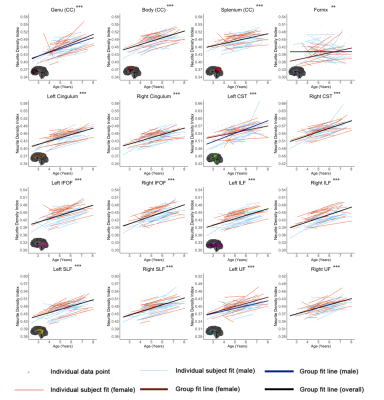 |
Characterizing axonal and myelin microstructure development across early childhood using NODDI and qihMT
Jess E Reynolds1,2, Emma Tarasoff3, R Marc Lebel1,4, Bryce L Geeraert1, and Catherine Lebel1
1Department of Radiology, University of Calgary, Calgary, AB, Canada, 2Telethon Kids Institute, The University of Western Australia, Perth, Australia, 3Department of Neuroscience, University of Calgary, Calgary, AB, Canada, 4GE Healthcare, Calgary, AB, Canada
There is a need to better understand white matter development across early childhood, as it is a time of rapid brain development that supports ongoing cognitive and behavioral maturation. Here, we aimed to apply NODDI and qihMT techniques longitudinally to provide a more specific understanding of early brain development. Consistent with diffusion MRI research, these advanced diffusion and non-diffusion methods indicated earlier development of central tracts compared to more peripheral regions. NODDI and qiHMT metrics demonstrate that white matter development during early childhood is dominated by increasing axon density, alongside ongoing myelination and slightly decreasing axon coherence.
|
||
2051.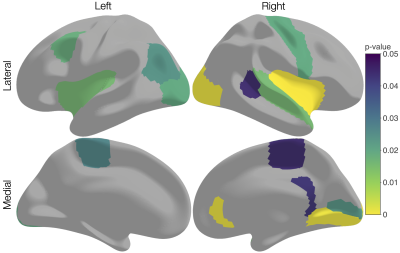 |
Investigating cortical microstructure in preterm-born adolescents using three-tissue compositional analysis
Thijs Dhollander1, Claire Kelly1,2, Ian Harding3,4, Wasim Khan3, Richard Beare1, Jeanie Cheong2,5,6, Lex Doyle2,5,6,7, Marc Seal1,7, Deanne Thompson1,2,7, and Peter Anderson2,8
1Developmental Imaging, Murdoch Children's Research Institute, Melbourne, Australia, 2Victorian Infant Brain Studies (VIBeS), Murdoch Children's Research Institute, Melbourne, Australia, 3Department of Neuroscience, Central Clinical School, Monash University, Melbourne, Australia, 4Monash Biomedical Imaging, Monash University, Melbourne, Australia, 5Newborn Research, The Royal Women's Hospital, Melbourne, Australia, 6Department of Obstetrics and Gynaecology, The University of Melbourne, Melbourne, Australia, 7Department of Paediatrics, The University of Melbourne, Melbourne, Australia, 8Turner Institute for Brain and Mental Health and School of Psychological Sciences, Monash University, Melbourne, Australia
While many studies have used diffusion MRI to investigate white matter microstructure, fewer studies have investigated cortical grey matter microstructure. We investigated cortical microstructural tissue and fluid composition using diffusion tissue signal fractions from Single-Shell 3-Tissue Constrained Spherical Deconvolution, in a cohort of preterm-born children at 13 years of age (n=130). Compared with term-born controls (n=45), we identified several cortical regions exhibiting a relative shift from a grey matter-like composition towards a more fluid-like composition, potentially reflecting reduced cell density and increased free-water content. This illustrates the utility of 3-tissue compositional analysis for studying cortical microstructure in neurodevelopment.
|
|||
2052.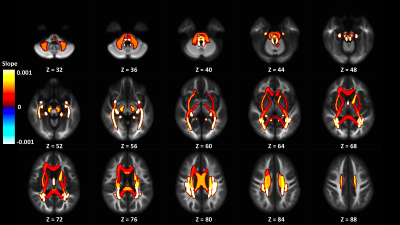 |
More than just axons: A positive relationship between an intracellular isotropic diffusion signal & pubertal development in white matter regions
Benjamin T Newman1,2, James T Patrie3, and T Jason Druzgal1
1Department of Radiology and Medical Imaging, University of Virginia, Charlottesville, VA, United States, 2Brain Institute, University of Virginia, Charlottesville, VA, United States, 3Department of Public Health Sciences, University of Virginia, Charlottesville, VA, United States
Understanding how the brain develops during adolescence is important for evaluating neuronal developments that affect mental health throughout the lifespan. This study uses 3-tissue constrained spherical deconvolution (3T-CSD) to examine the relationship between brain diffusion microstructure in deep white matter ROIs and pubertal development in a cross-sectional group of 4752 adolescents. An anisotropic diffusion signal fraction was found to have a negative correlation, while an intracellular isotropic diffusion signal fraction had a positive correlation with pubertal development across the majority of axonal ROIs. These results provide evidence for complex microstructural changes in brain development within the white matter skeleton.
|
|||
2053.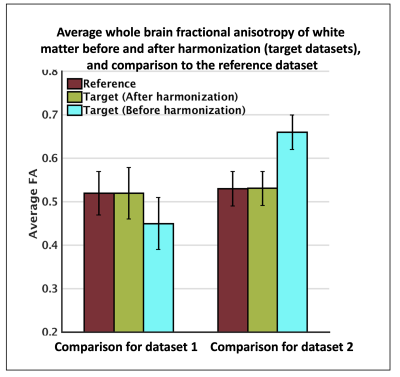 |
Harmonization of multi-site diffusion MRI data of the Adolescent Brain Cognitive Development (ABCD) Study
Suheyla Cetin-Karayumak1, Fan Zhang1, Tashrif Billah2, Sylvain Bouix1, Steve Pieper3, Lauren J. O'Donnell1, and Yogesh Rathi1
1Brigham and Women's Hospital and Harvard Medical School, Boston, MA, United States, 2Brigham and Women's Hospital, Boston, MA, United States, 3Isomics, Boston, MA, United States
This study presents our harmonization efforts on the multi-site diffusion MRI data of the ~12,000 adolescents from the Adolescent Brain Cognitive Development (ABCD) study, collected from 22 sites using Siemens, GE and Philips scanners. On the minimally preprocessed diffusion MRI data provided by the ABCD study - release 3, we first applied brain masking using our deep learning tool which showed 99% Dice overlap performance compared to the manually corrected masks. Next, we harmonized the dMRI data from 22 sites (with 45 scanner settings) using our previously-validated software. The harmonized diffusion MRI data will be shared through the NIMH data archive.
|
|||
2054.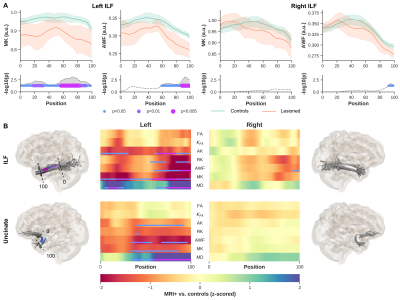 |
Characterizing Temporal Pole Microstructure with Diffusion Kurtosis Imaging in Temporal Lobe Epilepsy
Loxlan Wesley Kasa1,2, Terry Peters1,2,3,4, Seyed M Mirsattari3,4,5, Ali R Khan1,2,3, and Roy AM Haast1
1Imaging Research Laboratories, Robarts Research Institute, London, ON, Canada, 2School of Biomedical Engineering, Western University, London, ON, Canada, 3Department of Medical Biophysics, Western University, London, ON, Canada, 4Department of Medical Imaging, Western University, London, ON, Canada, 5Department of CNS, Western University, London, ON, Canada
The role of the temporal pole (TP) in nonlesional temporal lobe epilepsy (‘MRI-’) has been underappreciated. Better understanding of the possible white matter (WM) microstructural changes within the TP in MRI- is important for informing resective surgery. The purpose of this study was to evaluate the use of diffusion kurtosis imaging (DKI), to detect abnormalities at specific regions along WM fibre bundles proximal to the TP in MRI- and lesional TLE (‘MRI+’). DKI was able to detect possible microstructural changes near TP in both MRI+ and MRI- subjects not clearly visible using diffusion tensor imaging metrics.
|
|||
2055.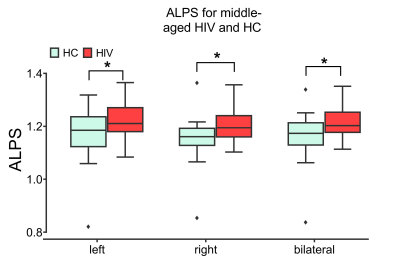 |
Assessment of Perivascular Glymphatic System Activity in Middle-aged HIV Infected Patients on Combination Antiretroviral Therapies
Benedictor Alexander Nguchu1, Jing Zhao 2,3, Yanming Wang1, Jean de Dieu Uwisengeyimana1, Xiaoxiao Wang1, Bensheng Qiu1, and Hongjun Li2,3
1Hefei National Lab for Physical Sciences at the Microscale and the Centers for Biomedical Engineering, University of Science and Technology of China, Hefei, China, 2Department of Radiology, Beijing Youan Hospital, Capital Medical University, Beijing, China, 3School of Biological Science and Medical Engineering, Beihang University, Beijing, China
The brain activity underlying cognitive processing can be affected by HIV. We examine the ALPS index, a measure reflecting glymphatic system activity, along the perivascular space and its relationship with cognitive performance in middle-aged HIV infected patients successfully adhering to antiretroviral therapy. We found that the ALPS index was increased significantly in middle-aged HIV-infected patients receiving cART and was correlated with attention and working memory. The duration on cART was also associated with some cognitive measures. These findings suggest that ALPS index might provide an impetus for understanding cognitively relevant diffusivity changes following HIV or long-term use of cART.
|
|||
2056.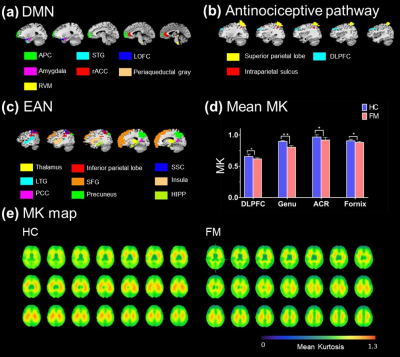 |
Altered Functional Connection and Neuroinflammation in Fibromyalgia Using Independent Component Analysis and Diffusion Kurtosis MRI
JIA-WEI Liang1, Tang-Jun Li2, Yao-Wen Liang3, Ting-Chun Lin3, Yi-Chen Lin3, Jiunn-Horng Kang2,4, You-Yin Chen3,5, and Yu-Chun Lo5
1Department of Biomedical Optoelectronic, Taipei Medical University, Taipei, Taiwan, 2College of Medicine, Taipei Medical University, Taipei, Taiwan, 3Department of Biomedical Engineering, National Yang Ming University, Taipei, Taiwan, 4Department of Physical Medicine & Rehabilitation, Taipei Medical University, Taipei, Taiwan, 5Ph.D. Program for Neural Regenerative Medicine, Taipei Medical University, Taipei, Taiwan
Recently, neuroinflammation was proposed as an important role in fibromyalgia. However, the correlation between neuroinflammation and functional connection in fibromyalgia patients remained unclear. Fibromyalgia patients and healthy control participants were recruited to investigate the mechanism of fibromyalgia. Independent component analysis, diffusion kurtosis MRI and cortical thickness estimation were applied in this study. The finding implied that neuroinflammation and structural change of brain were associated with the abnormal functional connection in fibromyalgia.
|
|||
2057.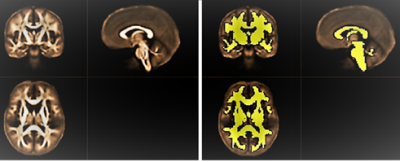 |
Clinical correlations of DTI and volumetric metrics in people with multiple sclerosis
Abdulaziz Alshehri1,2, Oun Al-iedani1,2, Jameen Arm1,2, Neda Gholizadeh1, Thibo Billiet3, Rodney Lea2, Jeannette Lechner-Scott1,2,4, and Saadallah Ramadan1,2
1University of Newcastle, Newcastle, Australia, 2Hunter Medical Research Institute, Newcastle, Australia, 3Icometrix, Leuven, Australia, 4John Hunter Hospital, Newcastle, Australia
This study is to evaluate DTI parameters in RRMS patients with age and sex-matched HCs, and to correlate these DTI metrics values in total-brain white matter (TBWM) and white matter lesion (WML) in comparison to white matter-related volumetric measures with clinical symptoms showing the differentiation and significant P-values. DTI parameters showed a stronger correlation with clinical parameters than white matter-related volumetric measurements in RRMS. Importantly, more DTI parameters (16 metrics) with stronger clinical correlations were obtained than volume measurements (5 metrics).
|
|||
2058.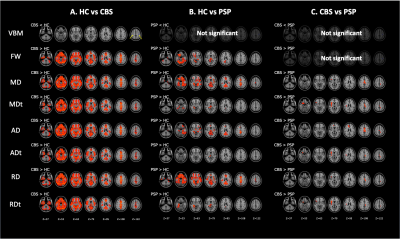 |
Microstructural Gray Matter Abnormalities in Progressive Supranuclear Palsy and Corticobasal Syndrome: Evaluation by Free-water Imaging
Koji Kamagata1, Christina Andica1, Kaito Takabayashi1, Yuya Saito1, Wataru Uchida1,2, Shohei Fujita1, Toshiaki Akashi1, Akihiko Wada1, Kouhei Kamiya3, Masaaki Hori3, and Shigeki Aoki1
1Department of Radiology, Juntendo University Graduate School of Medicine, Tokyo, Japan, 2Department of Radiological Sciences, Tokyo Metropolitan University, Tokyo, Japan, 3Department of Radiology, Toho University Omori Medical Center, Tokyo, Japan
Corticobasal syndrome (CBS) and progressive supranuclear palsy (PSP) are neurodegenerative disorders characterized by the deposition of the abnormal 4 microtubule-binding domain (4R) tau protein in specific brain regions. Voxel-based morphometry (VBM) has been widely used in CBS and PSD; however, the detection of pathological changes of these diseases is challenging in the early stages, including with VBM. In this study, we used free-water imaging (FWI) to evaluate gray matter (GM) microstructural changes in CBS and PSP. We determined that FWI could detect GM abnormalities, which likely reflected tau-related pathology in CBS and PSP patients more sensitively than VBM.
|
|||
2059.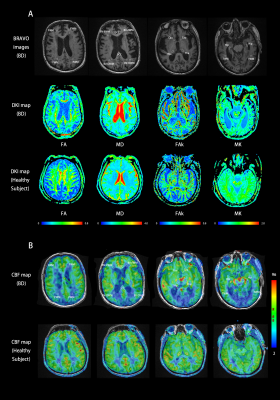 |
Can Diffusion Kurtosis Imaging and 3D-Arterial Spin Labeling perfusion imaging improve the diagnostic accuracy of Binswanger's Disease?
Xiaoyi He1,2, Weiqiang Dou3, Hansen Schie1, and Junying Wang1,2
1Department of Medical Imaging, Shandong Provincial Qianfishan Hospital, The First Hospital Affiliated with Shandong First Medical University, Jinan, China, 2Shandong First Medical University, Taian, China, 3GE Healthcare, MR Research China, Beijing, China
This study aimed to investigate whether the combined 3D-arterial spin labeling (3D-ASL) and diffusion kurtosis imaging (DKI) can distinguish Binswanger’s disease (BD) patients from healthy subjects. 35 BD patients and 33 age/gender-matched controls were scanned in DKI and ASL at 3T. Compared with healthy subjects, significant alterations were found in almost all DKI & ASL relevant parameters on the major lesions and partial non-lesion regions of BD. With these findings, we thus proved that the combined DKI and 3D-ASL can be effectively tools exploring pathophysiological mechanisms and performing robust diagnostic accuracy for BD patients.
|
|||
2060.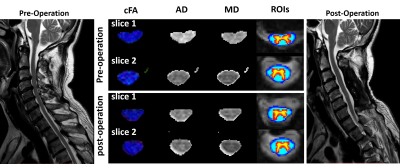 |
Evaluation of Multi-shot DTI Metrics at Non-Compressed Levels for the Diagnosis and Prognosis of Degenerative Cervical Myelopathy (DCM)
Sisi Li1, Ke Wang2, Xiao Han3, Jinchao Wang3, Wen Jiang3, Xiaodong Ma4, Bing Wu5, Yandong Liu3, Wei Liang3, and Hua Guo1
1Center for Biomedical Imaging Research, Beijing, China, 2Electrical Engineering and Computer Sciences, University of California, Berkeley, Berkeley, CA, United States, 3Beijing Jishuitan Hospital, Beijing, China, 4University of Minnesota, Minnesota, Minnesota, MN, United States, 5GE Healthcare, MR Research China, Beijing, China
Degenerative cervical myelopathy (DCM) is a chronic disease of spinal cord. The sensitivity of conventional structural T1W and T2W MRI to the diagnosis of DCM is low. Diffusion tensor imaging (DTI) can provide quantitative assessments for pre- and post-surgery spinal cord functions. However, the prognostic value of DTI metrics at the level-of-most-compression (LMC) remains controversial. Additionally, it is difficult to differentiate the clinical utility of various tracts at LMC due to severe compressions and limited resolution. This retrospective cohort follow-up study aimed to investigate the correlation of DTI metrics with clinical assessment in different tracts at non-compressed C2 level.
|
|||
2061.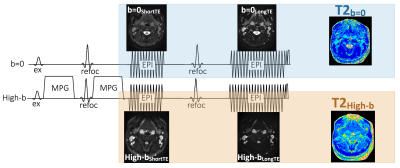 |
Differentiation of spinal epidural hematoma and infection in vertebral decompression patients using Diffusion-Relaxation Matrix (DRM)
Daichi Murayama1, Takayuki sakai1, Masami Yoneyama2, and Shigehiro Ochi3
1Radiology, Eastern Chiba Medical Center, Chiba, Japan, 2Philips Japan, Tokyo, Japan, 3Eastern Chiba Medical Center, Chiba, Japan
Postoperative complications such as vertebral decompression can lead to hematoma formation and infection. The differentiation of hematoma from infection as a postoperative follow-up is important in assessing future treatment options and the need for surgery. The aim of this study was to differentiate between spinal epidural hematoma, spinal epidural abscess and pyogenic spondylitis based on the ADC and T2 values obtained using DRM. The T2 and diffusion weighted T2 (ΔT2) values were significantly higher in abscesses than in hematomas, and even higher in pyogenic spondylitis.DRM allows to differentiate hematoma from infection.
|
|||
2062.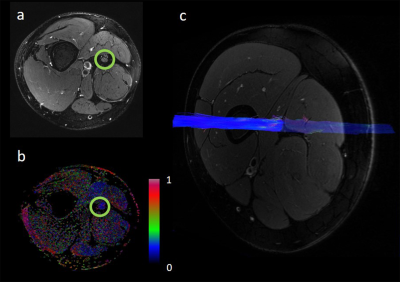 |
Decreased sciatic nerve fractional anisotropy in diabetes and prediabetes associated with lower and upper limb function impairment
Johann ME Jende1, Zoltan Kender1, Christoph Mooshage1, Sabine Heiland1, Peter Nawroth1, Martin Bendszus1, Stefan Kopf1, and Felix T Kurz1
1Heidelberg University Hospital, Heidelberg, Germany
Nerve damage in distal polyneuropathy first becomes clinically apparent in in the legs and later in hands and arms. Previous studies could show, however, that peripheral nerve lesions in the leg predominate in the thigh and that upper limb nerve function can be impaired in early stages of the disease. We show that a decrease in sciatic nerve fractional anisotropy is associated with impaired nerve function in both upper and lower limbs for patients with diabetes and patients with prediabetes. Our findings therefore suggest that structural nerve damage in diabetic polyneuropathy already occurs at early, subclinical stages of the disease.
|
The International Society for Magnetic Resonance in Medicine is accredited by the Accreditation Council for Continuing Medical Education to provide continuing medical education for physicians.